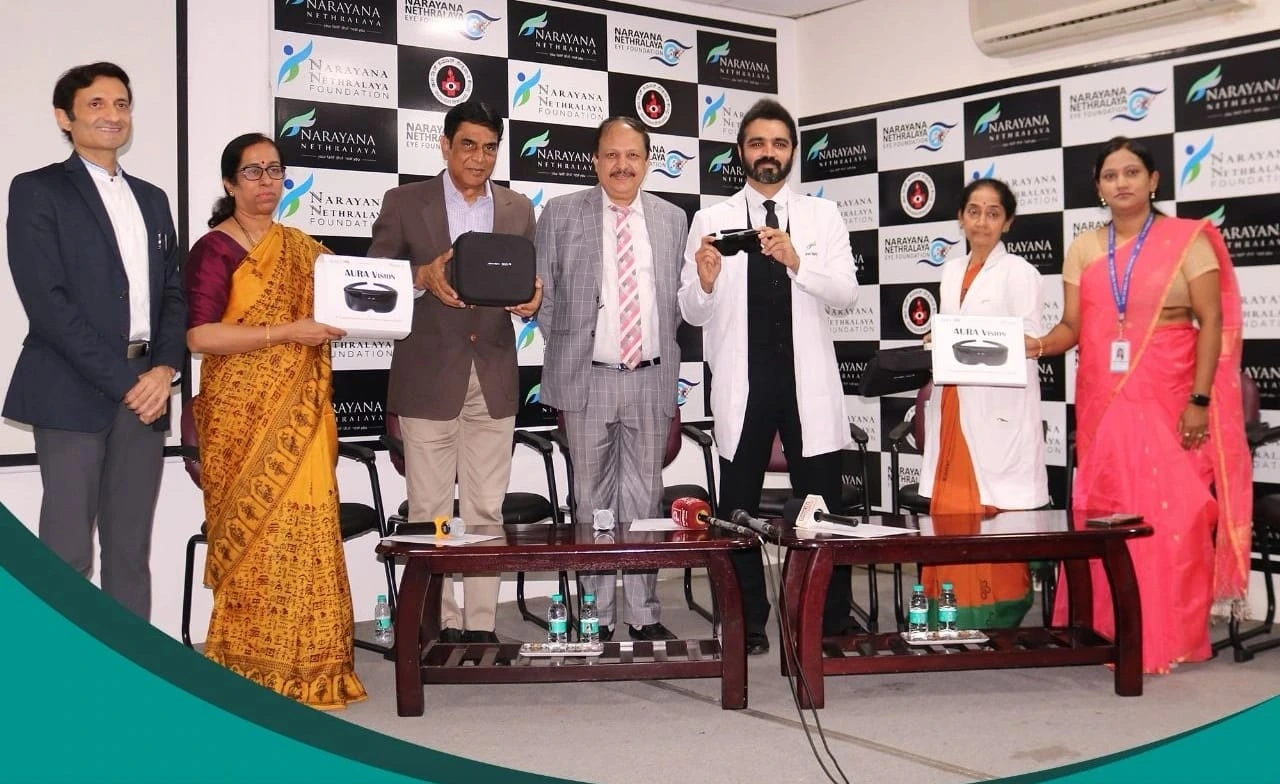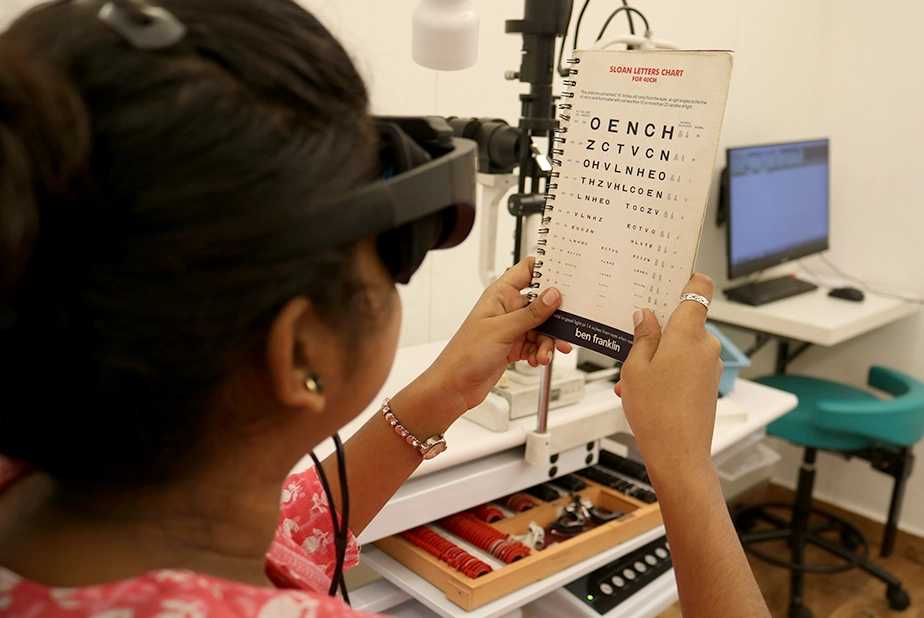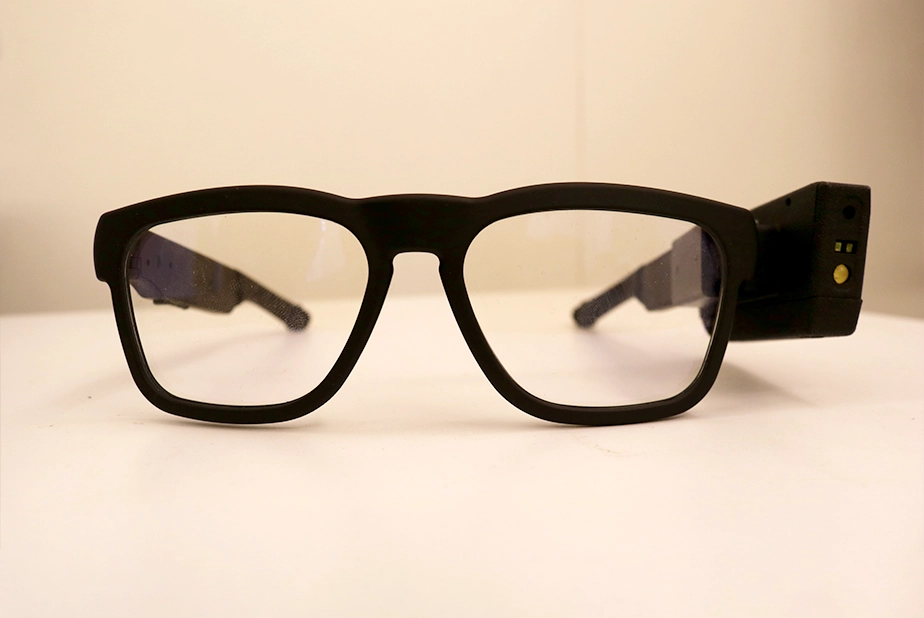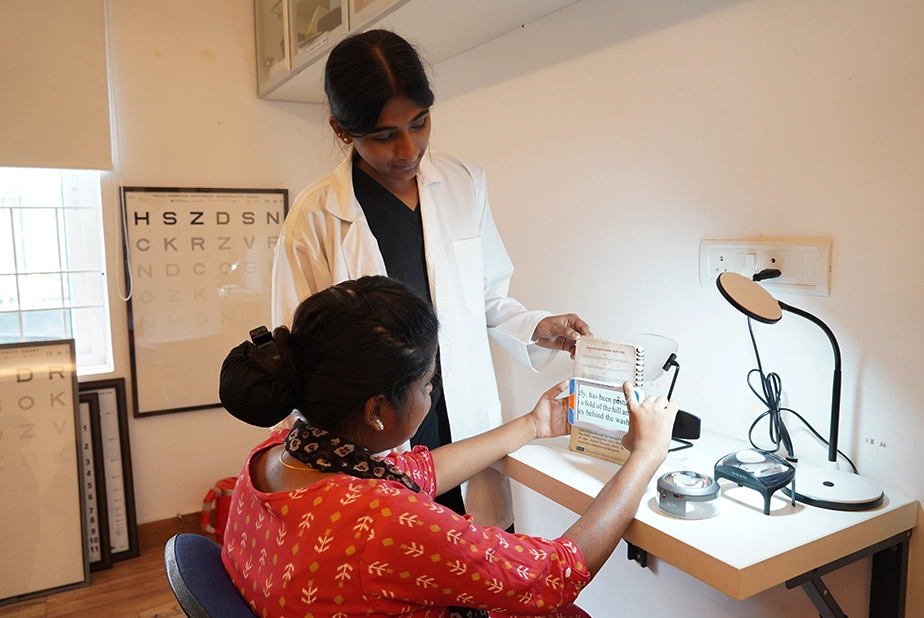Low Vision Clinic
Empowering Individuals with Visual Impairment
Our Low Vision Clinic is dedicated to providing specialized care and rehabilitation for individuals with visual impairments that cannot be fully corrected by standard glasses, contact lenses, medications, or surgery. We offer a range of condition-specific low vision devices to enhance the quality of life for our patients.
Condition-Specific Low Vision Devices
We prescribe specialized devices tailored to each patient’s specific condition:
- Condition
- Age-Related Macular Degeneration (AMD)
- Recommended Device
- Spectacle-mounted Telescopes
- Purpose
- Enhances central vision for distance tasks
- Condition
- Diabetic Retinopathy
- Recommended Device
- Portable Electronic Video Magnifiers
- Purpose
- Improves near vision with adjustable contrast/magnification
- Condition
- Glaucoma
- Recommended Device
- Field Expanders or Wide-Angle Lenses
- Purpose
- Aids peripheral awareness and mobility
- Condition
- Retinitis Pigmentosa
- Recommended Device
- Reverse Galilean Telescope
- Purpose
- Increases field of view
- Condition
- Stargardt’s Disease
- Recommended Device
- Smart Vision Glasses
- Purpose
- Assists in reading, mobility, and facial recognition
- Condition
- Albinism
- Recommended Device
- Photo chromatic Filters or Polarized Glasses
- Purpose
- Reduces glare and improves contrast
- Condition
- Optic Atrophy
- Recommended Device
- Dome Magnifier or CCTV
- Purpose
- Helps with reading and detail-oriented near work
Advanced Low Vision Devices
AURA Vision Glasses
Our Low Vision Clinic is dedicated to providing specialized care and rehabilitation for individuals with visual impairments that cannot be fully corrected by standard glasses, contact lenses, medications, or surgery. We offer a range of condition-specific low vision devices to enhance the quality of life for our patients.


Key Features
- Customizable Visual Settings: Adjust brightness, contrast, sharpness, and zoom to suit individual needs.
- Multiple Viewing Modes: Includes Reading Mode, Zoom Mode, and Wide Mode for versatile use.
- Voice and Gesture Assistance: Allows hands-free operation for ease of use.
- Ideal For: Individuals with central vision loss, peripheral vision loss, or blurry/hazy vision.
Benefits
- Enhanced Reading: Magnifies text and enhances contrast for easier reading.
- Improved Navigation: Wide-angle view aids in better spatial awareness.
- User-Friendly Interface: Voice and gesture controls facilitate seamless interaction.
Usage
AURA Vision Glasses are particularly beneficial for patients with conditions such as Age-Related Macular Degeneration (AMD), Glaucoma, and Retinitis Pigmentosa, offering them the ability to engage in daily tasks with greater independence.
Smart Vision Glasses
Overview: Smart Vision Glasses are wearable devices designed to assist individuals with severe visual impairments. Utilizing Artificial Intelligence (AI), Machine Vision, and Machine Learning, these glasses transform the user’s environment into an interactive experience.
Key Features
- Object Detection: Identifies and announces objects in the environment, such as vehicles, obstacles, and traffic signals.
- Reading Assistance: Reads text from books, signs, and digital screens in multiple languages, including Hindi, Tamil, Telugu, and English.
- Walking Assistance: Provides timely voice alerts for obstacles in the user's path.
- Face Recognition: Recognizes familiar faces to aid in social interactions.
- Affordable and Accessible: Designed to be cost-effective, making it accessible.
Benefits
- Enhanced Independence: Facilitates daily activities such as reading, navigation, and social interactions.
- Safety Features: Obstacle detection and face recognition enhance personal safety.
- Multilingual Support: Supports multiple languages, catering to diverse linguistic needs
Usage
Smart Vision Glasses are suitable for patients with conditions like Stargardt’s Disease, Optic Atrophy, and Severe Glaucoma, providing them with tools to navigate their environment and perform daily tasks with greater ease.

Types of Low Vision Aids Provided
Optical Devices
- Distance Devices: Spectacle-mounted telescopes, monocular, and reverse telescopes to enhance distant vision.
- Near Devices: Handheld and stand magnifiers, high-powered reading glasses, and video magnifiers for close-up tasks.
Non-Optical Devices
- Reading Aids: Bold-line paper, reading stands, and task lighting lamps.
- Writing Aids: Writing guides and bold-line pens.
- Time and Date Aids: Talking clocks and large-print calendars.
- Technology Aids: Screen readers and magnification software.

Patient Workup and Rehabilitation Process
- Comprehensive Eye Examination: Assess visual acuity, contrast sensitivity, and field of vision.
- Functional Vision Assessment: Evaluate the impact of visual impairment on daily activities.
- Device Selection: Recommend appropriate low vision aids based on individual needs.
- Training and Orientation: Provide instruction on the use of selected devices and techniques for maximizing remaining vision.
- Follow-Up Care: Regular monitoring and adjustments to ensure optimal device performance and patient satisfaction.
Conclusion
At our Low Vision Clinic, we are committed to enhancing the lives of individuals with visual impairments through personalized care and advanced technology. By integrating devices like the AURA Vision Glasses and Smart Vision Glasses, we empower our patients to lead more independent and fulfilling lives.
Frequently Asked Questions
My vision can't be fixed with glasses or surgery. Can anything still help?
Yes. Low vision devices can help you use your remaining sight for reading, watching TV, walking, and more.
What are low vision devices exactly?
They’re tools like magnifiers, telescopes, or smart glasses that help you do everyday tasks more easily.
I can’t read small print. What should I use?
You can use reading magnifiers, strong reading glasses, or video magnifiers that zoom and enhance text.
I struggle to see bus numbers and faces. What can help?
Telescopic glasses, monocular, or smart glasses can help you see things clearly from a distance.
I feel unsafe while walking. Are there devices to help me move better?
Yes. Devices like field expanders or AURA Vision Glasses help detect steps, objects, and guide you safely.
I’ve tried magnifiers before. They didn’t work. Now what?
There are better options now, like digital magnifiers or wearable smart glasses. We’ll help you try what suits you.
Are these devices hard to use? I’m not good with tech.
No. Many are simple. We’ll train you step-by-step and help you find the easiest one to use.
Can these devices help my child in school?
Yes. We suggest portable magnifiers, telescopes, and writing aids to help your child see better in class.
Will these devices bring back full vision?
No, but they can help you read, walk, recognize faces, and stay independent in daily life.